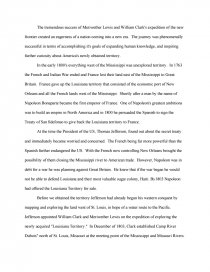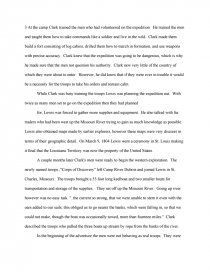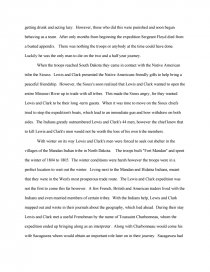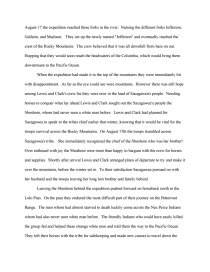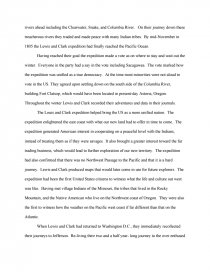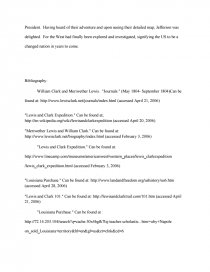Louis and Clark
Essay by review • March 7, 2011 • Research Paper • 2,366 Words (10 Pages) • 1,399 Views
The tremendous success of Meriwether Lewis and William Clark's expedition of the new frontier created an eagerness of a nation coming into a new era. The journey was phenomenally successful in terms of accomplishing it's goals of expanding human knowledge, and inspiring further curiosity about America's newly obtained territory.
In the early 1800's everything west of the Mississippi was unexplored territory. In 1763 the French and Indian War ended and France lost their land east of the Mississippi to Great Britain. France gave up the Louisiana territory that consisted of the economic port of New Orleans and all the French lands west of the Mississippi. Shortly after a man by the name of Napoleon Bonaparte became the first emperor of France. One of Napoleon's greatest ambitions was to build an empire in North America and in 1800 he persuaded the Spanish to sign the Treaty of San lldefonso to give back the Louisiana territory to France.
At the time the President of the US, Thomas Jefferson, found out about the secret treaty and immediately became worried and concerned. The French being far more powerful than the Spanish further endangered the US. With the French now controlling New Orleans brought the possibility of them closing the Mississippi river to American trade. However, Napoleon was in debt for a war he was planning against Great Britain. He knew that if the war began he would not be able to defend Louisiana and their most valuable sugar colony, Haiti. By1803 Napoleon had offered the Louisiana Territory for sale.
Before we obtained the territory Jefferson had already begun his western conquest by mapping and exploring the land west of St. Louis, in hope of a water route to the Pacific. Jefferson appointed William Clark and Meriwether Lewis on the expedition of exploring the newly acquired "Louisiana Territory." In December of 1803, Clark established Camp River Dubois" north of St. Louis, Missouri at the meeting point of the Mississippi and Missouri Rivers. 3 At the camp Clark trained the men who had volunteered on the expedition. He trained the men and taught them how to take commands like a soldier and live in the wild. Clark made them build a fort consisting of log cabins, drilled them how to march in formation, and use weapons with precise accuracy. Clark knew that the expedition was going to be dangerous, which is why he made sure that the men not question his authority. Clark new very little of the country of which they were about to enter. However, he did know that if they were ever in trouble it would be a necessity for the troops to take his orders and remain calm.
While Clark was busy training the troops Lewis was planning the expedition out. With twice as many men set to go on the expedition then they had planned
for, Lewis was forced to gather more supplies and equipment. He also talked with fur traders who had been west up the Missouri River trying to gain as much knowledge as possible. Lewis also obtained maps made by earlier explorers, however these maps were very discreet in terms of their geographic detail. On March 9, 1804 Lewis went a ceremony in St. Louis making it final that the Louisiana Territory was now the property of the United States.
A couple months later Clark's men were ready to begin the western exploration. The newly named troops ;"Corps of Discovery" left Camp River Dubois and joined Lewis in St. Charles, Missouri. The troops brought a 55 foot long keelboat and two smaller boats for transportation and storage of the supplies. They set off up the Missouri River. Going up river however was no easy task. "..the current so strong, that we were unable to stem it even with the oars added to our sails; this obliged us to go nearer the banks, which were falling in, so that we could not make, though the boat was occasionally towed, more than fourteen miles." Clark described the troops who pulled the three boats up stream by rope from the banks of the river.
In the beginning of the adventure the men were not behaving as real troops. They were getting drunk and acting lazy. However, those who did this were punished and soon begun behaving as a team. After only months from beginning the expedition Sergeant Floyd died from a busted appendix. There was nothing the troops or anybody at the time could have done. Luckily he was the only man to die on the two and a half year journey.
When the troops reached South Dakota they came in contact with the Native American tribe the Siouxs. Lewis and Clark presented the Native Americans friendly gifts to help bring a peaceful friendship. However, the Sioux's soon realized that Lewis and Clark wanted to open the entire Missouri River up to trade with all tribes. This made the Sioux angry, for they wanted Lewis and Clark to be their long -term guests. When it was time to move on the Sioux chiefs tried to stop the expedition's boats, which lead to an immediate gun and bow withdraw on both sides. The Indians greatly outnumbered Lewis and Clark's 44 men, however the chief knew that to kill Lewis and Clark's men would not be worth the loss of his own tribe members.
With winter on its way Lewis and Clark's men were forced to seek out shelter in the villages of the Mandan Indian tribe in North Dakota. The troops built "Fort Mandan" and spent the winter of 1804 to 1805. The winter conditions were harsh however the troops were in a perfect location to wait out the winter. Living next to the Mandan and Hidatsa Indians, meant that they were in the West's most prosperous trade route. The Lewis and Clark expedition was not the first to come this far however. A few French, British and American traders lived with the Indians and even married members of certain tribes. With the Indians help, Lewis and Clark mapped out and wrote in their journals about the geography, which lied ahead. During their stay Lewis and Clark met a useful Frenchman by the name of Toussaint Charbonneau, whom the expedition ended up bringing along as an interpreter. Along with Charbonneau would come his wife Sacagawea whom would obtain an important role later on in their journey. Sacagawea had been captured by Hidatsa warriors years earlier and was taken from her homelands in the Rocky Mountains. Planning ahead Lewis and Clark knew that once they entered the Rocky Mountains Sacagawea could be a huge help in conversing with her people in terms of supplies in order to make it over the mountains.
In April it was finally time to set out into the true unknown. Land only to have been walked by Indians in the past. Before leaving they sent the keelboat back to St. Louis with a collection of animals, plant specimens, letters, reports, and maps that could be of some reference to Jefferson in how the
...
...
